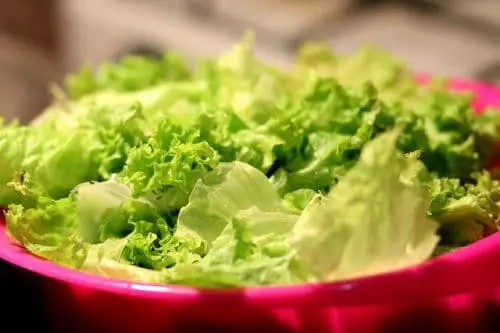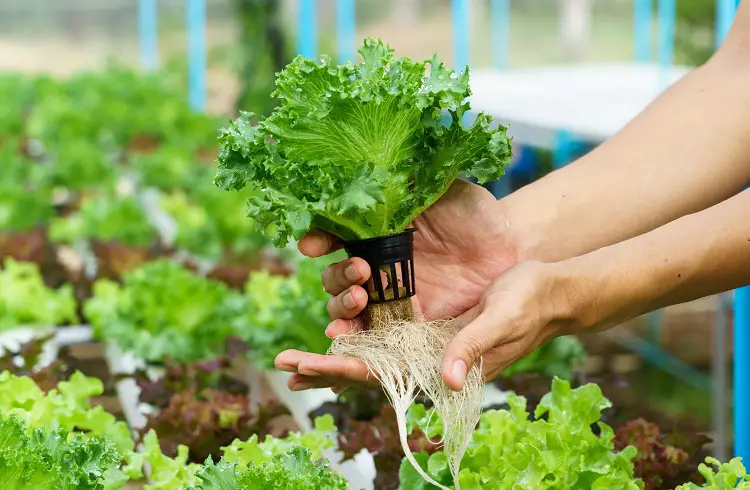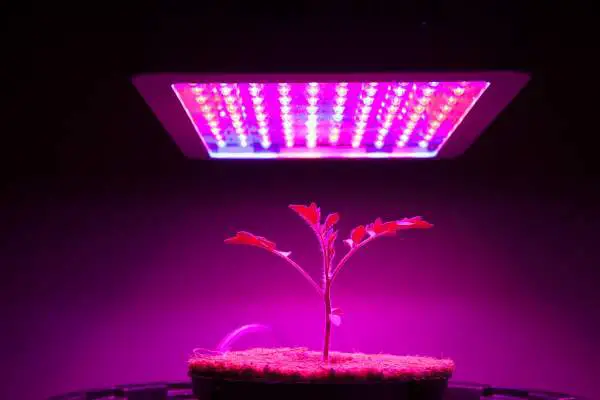Lettuce is one of the easiest things to grow in hydroponics. You have taken up the challenge and nurtured your seeds into germination and transferred them to your hydroponics system. You have your first harvest washed and sitting in the salad bowl, but something isn’t right.
Why is my hydroponic lettuce bitter? Lettuce might be one of the easiest things to grow hydroponically. However, if you have either a nutrient-rich solution, a growing environment which is too hot, or your lighting setup isn’t at its most optimum, you will get bitter lettuce.
Do you want to grow lettuce which is full of flavor and has no aftertaste? Do you want to know what is causing it, what you can do to resolve the problem, and is it too late to save your current batch of lettuce? Find out with the answers to the questions below.
Why Does my Hydroponic Lettuce Taste Bitter?
With Hydroponics, you have full control over growing conditions, and because of this, it means there are no outside influences so you can narrow down where to start looking. The first area to check will be your nutrients.
Lettuce doesn’t require too many nutrients to flourish. So, if your mix is too rich, it can lead to the bitter taste you have experienced. Although flushing your system is not vital to grow tasty lettuce, it can help improve flavor and remove the bitter taste.
System flushing can be more critical in ebb and flow systems. These continually fill with nutrient-rich water, and then once they drain they begin to dry out. It is during the drying process when mineral salts and nitrates start sticking to everything, including the roots of your lettuce. Veteran hydroponic growers recommend flushing a system before harvesting, even though it isn’t necessary.
Flushing the Hydroponic System
It is these nitrates and mineral salts which can be the most significant cause of bitter tasting lettuce. Flushing depends on the type of hydroponic system you are using. The first thing to do is drain all the nutrient solutions from your tank. Once you have emptied the system, you then need to proceed by rinsing your tanks and hoses with plain water.
If you have a nitrate-rich nutrient mix, you will need to rinse the system two or three times. Once done, you then need to adjust your pH levels to 6.0. Both pH Up and Down plus a Testing Kit can be found online from Walmart, or they will be available from your local hydroponic supplier.
Now, you should leave your system to run for a few hours. If it is the last flush before your lettuce harvest, you can let the plain water run through your system for up to one week.
After doing this, you need to drain the system again and thoroughly rinse your hoses. You should also flush the sides of your tank and check for any buildup or debris. If there is debris, or your system doesn’t appear to be as clean as it should. Then fill the system with your pH adjusted water, rerun your system for a couple of hours, and then finally drain the system.
Any algae or nitrate buildup needs removing, and all sides of the tank wiped. Hoses need cleaning inside, as far as you can reach. Once done, mix a new batch of your nutrient solution while checking it isn’t too rich for your lettuce. Once done, refill your system and let it run.
Items for Flushing the System
Here are some of the things you will need when you flush your system.
- Hydroponic nutrients
- Water pH testing kit
- Chemical water adjusting kit
- Buckets and hoses
Heat Can Cause Lettuce to Taste Bitter
Lettuce is a cool weather plant. If the air temperature rises over 75F (24°C), your lettuce begins producing chemicals for flowering and producing seeds. It is this which can be one of the causes of for the bitter taste depending on the location of your hydroponics system and your region. This will determine how you can control the temperature of your growing environment.
To be accurate in your temps, it is worth investing in a Digital Hygrometer Indoor Thermometer. You can then periodically check your temperatures and humidity. If you are growing inside a greenhouse, there is one mistake many people make, and that is to shade the plants. Shading, unfortunately, isn’t the answer and you should be looking at ventilation or a form of cooling.
Evaporative cooling is the best option and can be from either a fan and wet-pads system, a low-pressure misting system or high-pressure fog system. All these should be used in conjunction with mechanical or natural ventilation. As a last resort a shade curtain can be used, but for no more than up to four hours and only during the hottest part of the day.
Incorrect Lighting Can Make Lettuce Bolt and Taste Bitter
If you are growing indoors and using artificial lighting, then things can be easier to control. Generated heat comes from your lighting, and the worst culprits being HID (High-Intensity Discharge) growing lights. You can help combat this if you see the overall room temperature is increasing.
You can place your lights inside an air-cooled reflector where the coolest air possible is ducted to the reflector, and then vents from inside your room via insulted ducting to prevent heat transferring back inside and affecting the ambient temperature.
You have seen, heat generated from grow lights raises the temperature of indoor grow rooms. There are three basic elements included in this section. One, the lights are not the best type and produce too much heat. Two, the length of time your grow lights are turned on is too long, and there is little or no adjustment of lights when required. Finally, the best bulb or tube type isn’t being used.
The positioning of lights can be the quickest variable to resolve, and no matter what artificial lighting method you are using, light sources should be around 4-6 inches above your plants. As they grow, the distance needs adjusting to maintain this gap. Because lettuce is a fast grower, it is crucial to keep a constant check on their progress so you can manage the optimum growing distance.
Light Quality Affects the taste of Lettuce
For lettuce to grow successfully, it requires a minimum of 12 hours of light. The ideal amount of light for most plants is 14 – 16 hours. If your growing location makes use of natural light, this needs to be used in your calculation for how long you will be using grow lights. Winter time has fewer sunlight hours, and this means you will be using your grow lights for longer. If you either leave them on too long or even forget to turn them on at the correct time, it plays havoc with your plants growing schedule.
The final element is the type of grow lights you are using. There are a few types to choose, and these include LED grow panels, HID lamps and Fluorescent tubes. LED’s are finally catching up and require further discussion which leaves HID and Fluorescent.
HID grow lights are the lighting type which generates lots of heat. These are recommended for more experienced users and are the lighting types which require cooling. Fluorescent tubes are more suited to growing lettuce because they run much cooler, but even differences in these lighting tubes can affect the growth of lettuce.
T5 fluorescent tubes are the best choice over T8 or T12 tubes, even though they require different fittings. They also give off more heat than these other varieties, but allowing for this, it is the Kelvin rating which can be a reason you are finding bitter tasting lettuce.
T5 fluorescent grow lights are the most efficient of all fluorescent tubes. However, tubes with a 6500 Kelvin rating deliver a full spectrum of light, which is excellent for overall growth. Lighting tubes with a 3000 Kelvin rating produce more red spectrum light which helps encourage flowering or bolting too early.
Related Questions
How Can I Get the Bitter Taste Out of Leaf Lettuce?
It can help to separate the leaves and put them in a bowl of cold water with a pinch of baking soda. Soak for ten minutes, rinse and soak again in plain water. Drain and serve. You can also use a salad crisper, or place the lettuce leaves in the refrigerator overnight.
What is the best lettuce variety to grow hydroponically?
Many growers choose leaf lettuce (Lactuca Sativa) along with the Tom Thumb variety. The Tom Thumb variety is easy to handle and grows large enough for one head to be enough for two people. Romaine lettuce, on the other hand, takes longer to mature, so it could be more prone to becoming bitter.
How long does hydroponic lettuce take to grow?
Nearly all varieties of lettuce can be grown in a hydroponic system. Leafy lettuce varieties are the recommendation because they can grow to harvest in half the time of head varieties of lettuce. When conditions are right, you can expect to be harvesting lettuce in three to four weeks.





